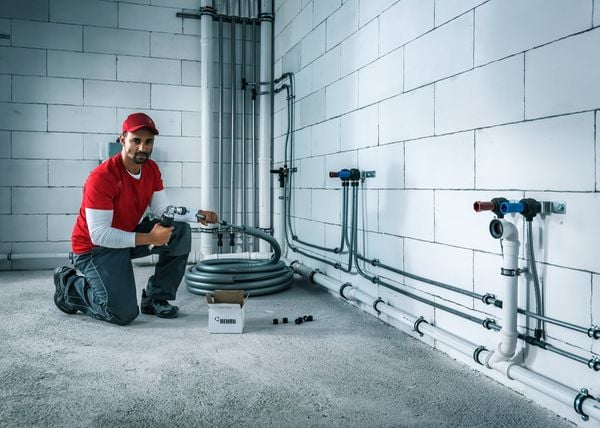Revealing the Next Chapter of Plumbing: Developments and Innovations
Revealing the Next Chapter of Plumbing: Developments and Innovations
Blog Article
Do you find yourself interested in advise concerning The Future Of Plumbing: Trends And Technologies To Watch?

Introduction
The plumbing industry is going through a transformative stage driven by technical advancements and growing issues for sustainability and performance. This short article discovers arising patterns and innovations shaping the future of plumbing.
Smart Pipes Equipments
Integrating wise modern technology into pipes systems enables remote tracking, leak detection, and automated upkeep. Smart sensors and IoT (Net of Points) devices allow house owners and plumbing professionals to keep track of water usage and identify concerns in real-time, resulting in a lot more efficient resource monitoring and positive upkeep.
Water Performance Solutions
With increasing focus on water preservation, innovative services are being developed to decrease water wastefulness in plumbing systems. High-efficiency components, greywater recycling systems, and clever irrigation controllers are among the innovations assisting consumers decrease their water impact while keeping comfort and convenience.
Lasting Materials
The change towards sustainability extends to pipes products, with a growing choice for green choices. Naturally degradable piping products, such as PEX (cross-linked polyethylene) and HDPE (high-density polyethylene), deal resilience and resistance to rust without endangering environmental honesty.
Predictive Upkeep
Anticipating maintenance techniques take advantage of data analytics and artificial intelligence formulas to anticipate and stop pipes concerns before they happen. By examining historical data and performance metrics, anticipating upkeep algorithms can recognize patterns and anomalies, enabling proactive treatments to avoid expensive fixings and disruptions.
Augmented Truth in Plumbing
Increased Truth (AR) technology is transforming pipes by giving technicians with real-time visual advice for repairing and repair tasks. AR-enabled wise glasses or mobile applications overlay digital information onto the physical environment, helping plumbing professionals visualize pipeline formats, recognize surprise leakages, and execute fixings with precision.
Effect of 3D Printing
The development of 3D printing has introduced brand-new possibilities in making plumbing parts. From custom-made fixtures to complex pipeline fittings, 3D printing permits rapid prototyping and on-demand production, minimizing preparations and enabling higher personalization in plumbing design.
Health and Safety Features
In response to enhanced issues for health and wellness, pipes fixtures are integrating features such as antimicrobial surface areas, touchless procedure, and self-cleaning mechanisms. These innovations not only improve hygiene yet additionally promote customer convenience and benefit.
Hygiene-focused Fixtures
Touchless taps, self-sanitizing commodes, and antimicrobial surfaces are ending up being increasingly widespread in property and business setups, lessening the risk of bacterium transmission and advertising a cleaner, much healthier atmosphere.
Water High Quality Surveillance
Advancements in water high quality tracking technologies make it possible for homeowners to keep an eye on the pureness and safety of their water supply in real-time. Smart water quality sensors can discover pollutants, pH degrees, and temperature level variants, encouraging users to take proactive steps to ensure water safety.
Remote Plumbing Providers
Remote diagnostics and online support are reinventing the way pipes solutions are supplied. Through video conferencing and remote accessibility modern technologies, plumbing professionals can troubleshoot issues, provide guidance for do it yourself fixings, and even do remote inspections, providing greater ease of access and comfort to house owners.
Difficulties and Opportunities
While plumbing developments hold immense promise, they also existing challenges such as information privacy problems, governing compliance, and the demand for workforce training. Attending to these obstacles needs collaboration in between industry stakeholders and governing bodies to make sure risk-free and accountable implementation of new innovations.
Regulative Landscape
Regulatory structures play an important duty in shaping the fostering of plumbing technologies, with requirements and codes controling everything from water effectiveness to product safety. As technologies remain to advance, governing bodies must adapt to make sure customer security and ecological stewardship.
Future Expectation
The future of plumbing is defined by continued development and combination with other fields such as IoT, renewable resource, and building automation. By welcoming sustainable practices, leveraging arising modern technologies, and focusing on user-centric layout, the pipes market is positioned to resolve the developing requirements of society while decreasing its environmental impact.
Verdict
In conclusion, the future of plumbing is defined by a convergence of modern technology, sustainability, and user-centric design. By accepting clever solutions, lasting products, and proactive maintenance methods, the plumbing market can enhance performance, advertise safety, and add to an extra sustainable future.
Plumbing Industry Trends You Need To Know
Smart technology in plumbing
Homeowners want to be able to manage their homes from their phones. The technology exists to make that happen. From smart toilets to leak detector devices, the whole plumbing system can be managed on an interconnected network made up of sensors, IoT devices, and machine learning algorithms.
This allows for wireless control to turn appliances on and off, automate routines, and access advanced monitoring to track water usage and flag potential issues. Smart technology streamlines water consumption, maintenance and energy usage, creating a more efficient system.
Green plumbing
The data analysis possible with smart technology not only improves convenience and cost-effectiveness but also fulfills a high-priority customer desire – sustainability. Consumers are very aware of their impact on the planet and want plumbing solutions to reduce damage and support sustainability. Eco-friendly plumbing solutions are already starting to emerge.
Customers can opt for low-flow toilets, water-saving faucets, and connections to sustainable energy sources. Beyond monitoring water consumption, customers can conserve water through the installation of greywater systems. This is a system that collects water that has been used but is still clean enough for some household uses such as toilet flushing.
Shorter product pipeline
To keep up with modern plumbing, plumbers need modern tools that enable them to complete jobs more efficiently. One technology making strides in this area is 3D printing. By 3D printing key plumbing fixtures, plumbers can reduce wait times even for specialized fixtures. It minimizes delays often seen in traditional manufacturing that frustrate customers and prevent plumbers from taking on more work.
Off-site repairs
Augmented reality is making a splash in many industries including plumbing. Plumbers can map a building online so they can explore the plumbing system through augmented reality, identifying areas of maintenance and repair completely digitally. This technology can be applied quite widely in plumbers’ work including planning installations and training new recruits. It’s safer, smarter and more efficient.
Low-footprint materials
Another way for plumbing companies to reduce their environmental footprint and meet the customer demand for sustainability is by using recycled materials in their work. The products they source and manufacture such as pipes, fixtures and faucets can be made from recycled materials. This saves the planet while being just as effective.
Onsite water purification
Additionally, plumbing companies can be advocates of water conservation and ease the financial and environmental concerns of customers by offering water purification systems. New water purification technology such as reverse osmosis systems and UV systems make it possible for homeowners and business owners to thoroughly cleanse water, removing contaminants onsite. This means the water can be safely reused in more ways than greywater can be, establishing a water recycling loop.
Tankless water heaters
Another innovation of modern plumbing is tankless water heaters. The idea is that the water is heated on demand as it runs through the system instead of being heated in a water tank. This is more energy efficient and therefore cost-effective and eco-friendly because water isn’t heated needlessly.

As a passionate person who reads about The Future of Plumbing: Trends and Innovations to Watch, I figured sharing that piece of writing was worth the trouble. Sharing is caring. One never knows, you will be doing someone a favor. Thanks for being here. Kindly pay a visit to our blog back soon.
Source Report this page